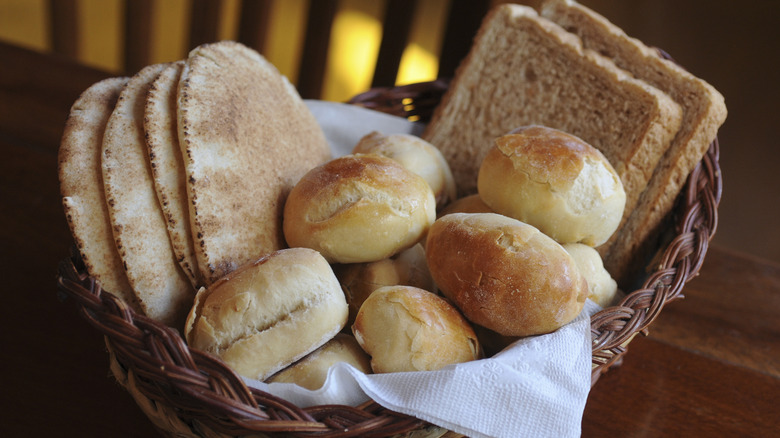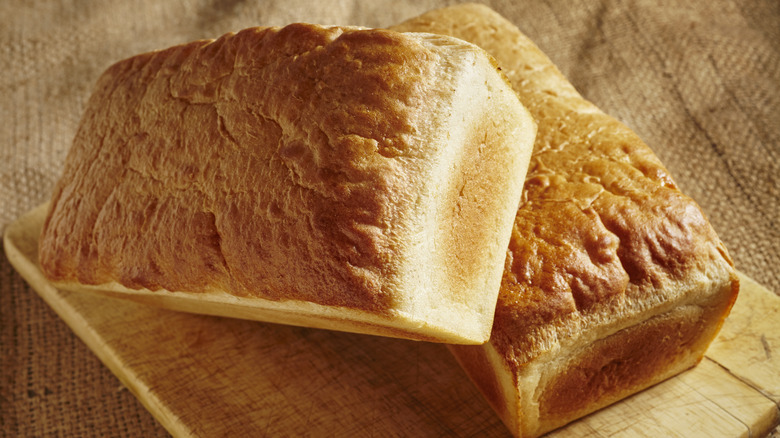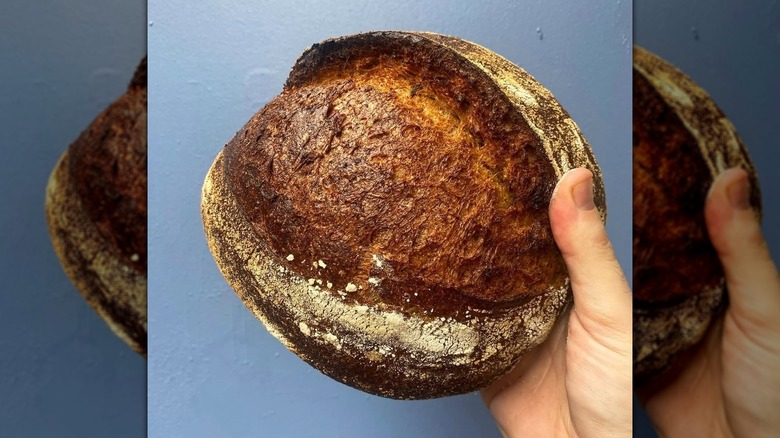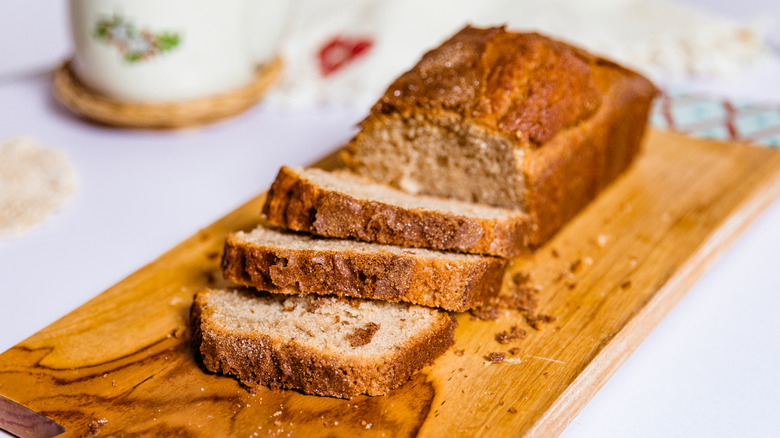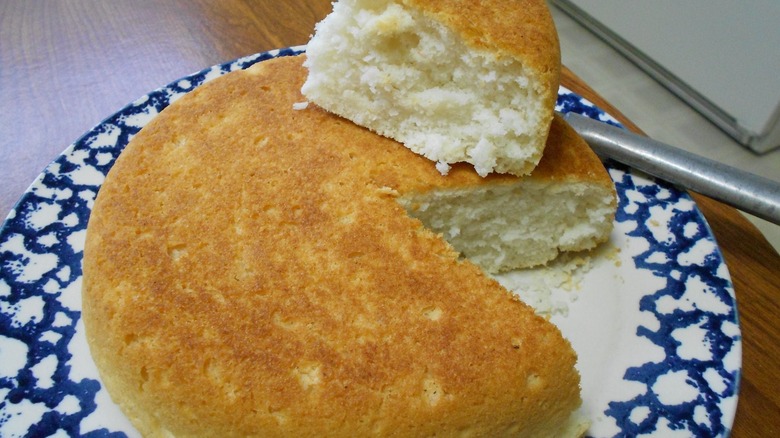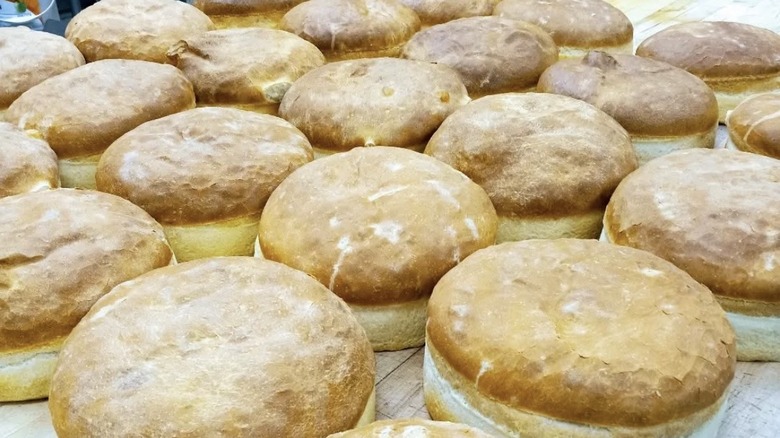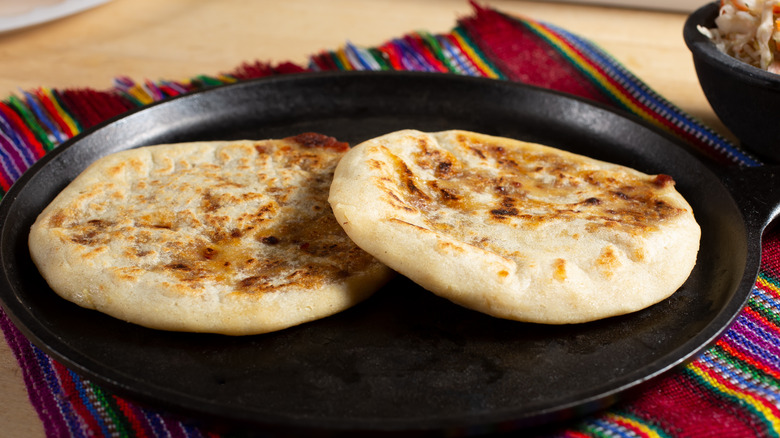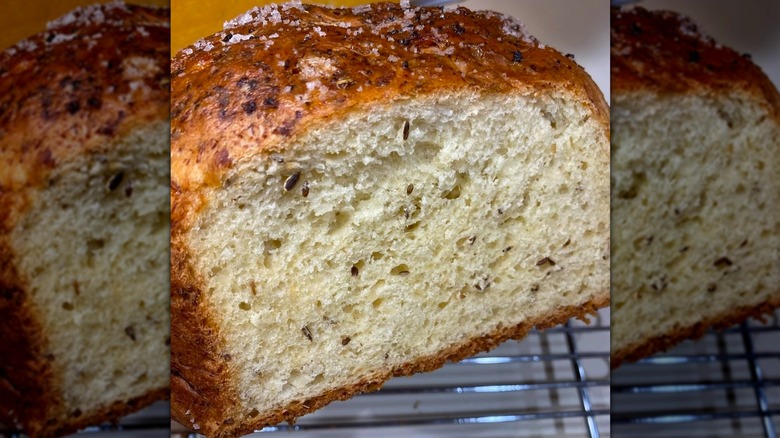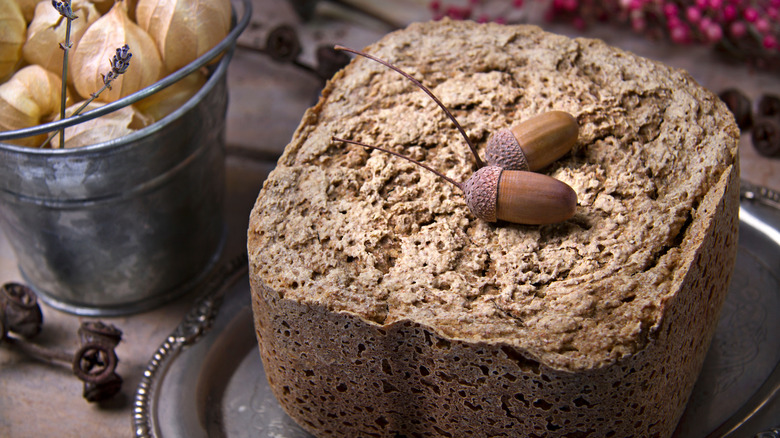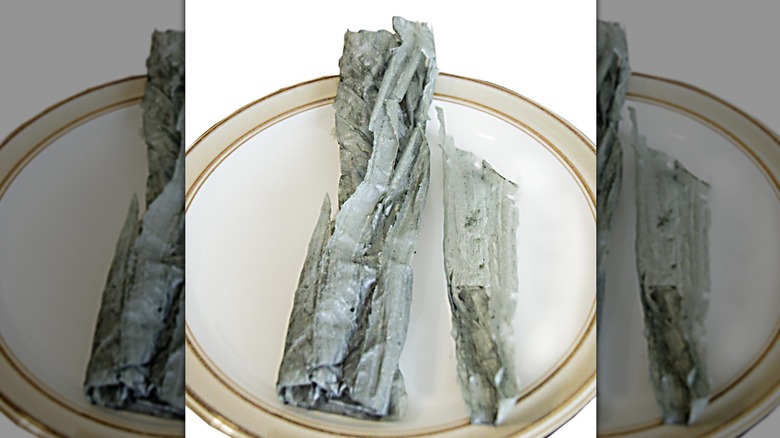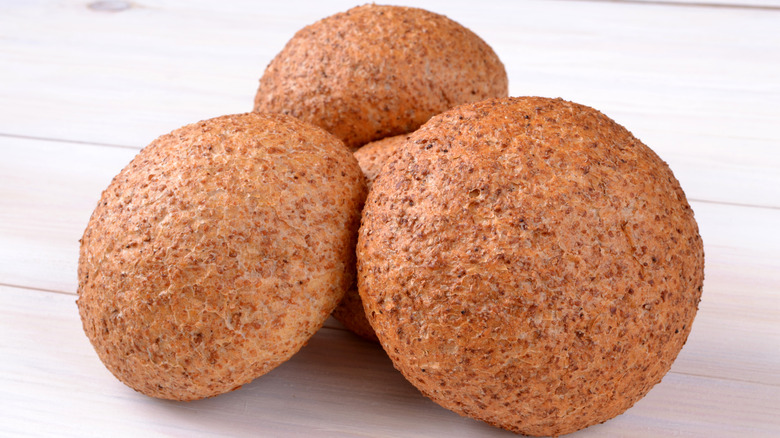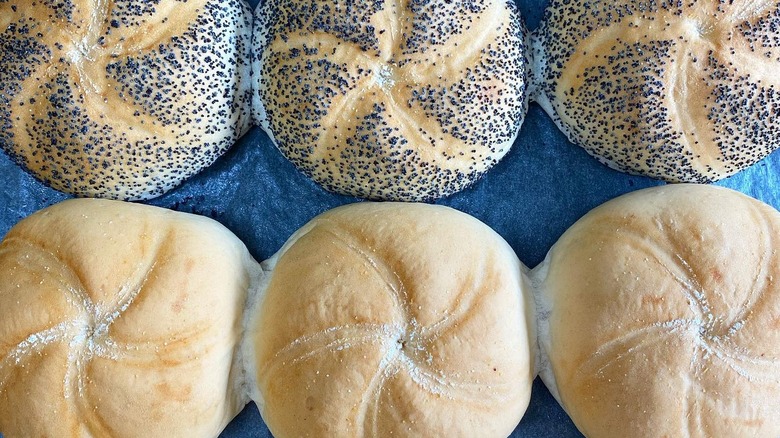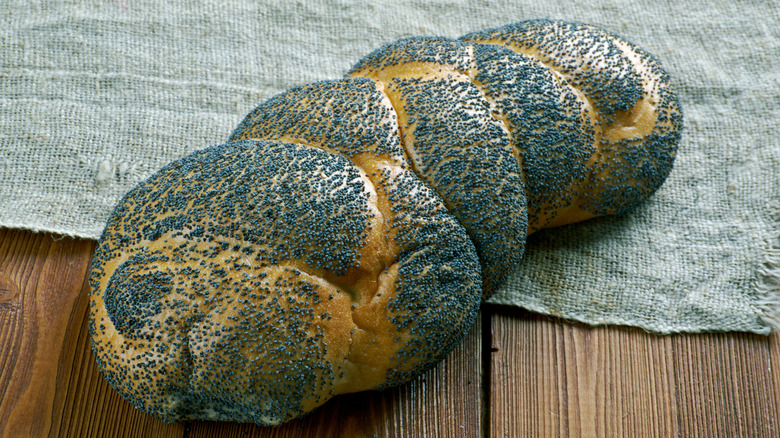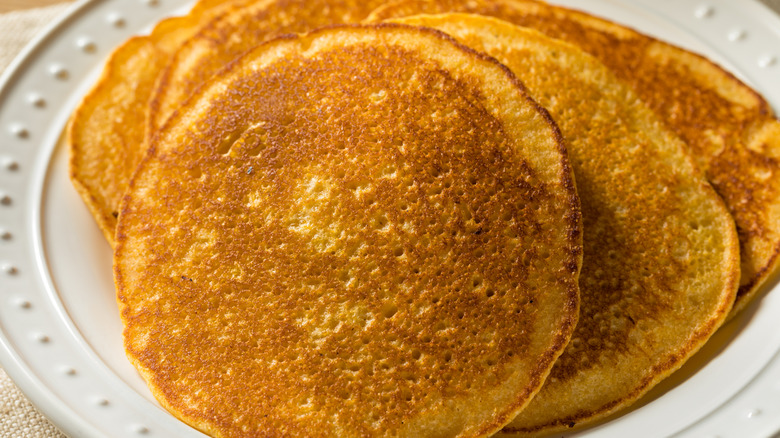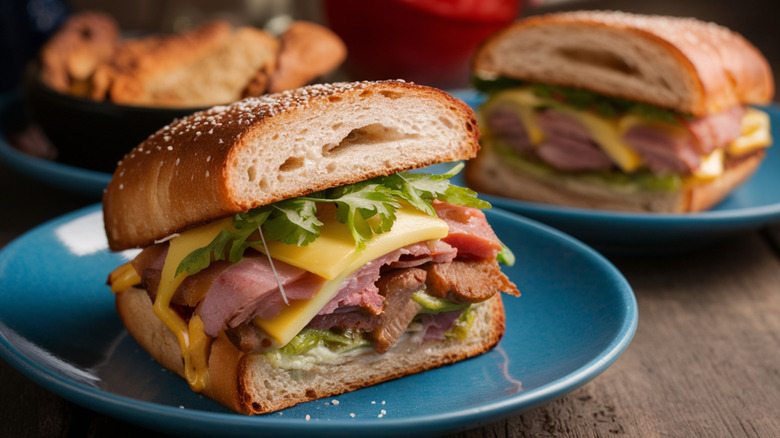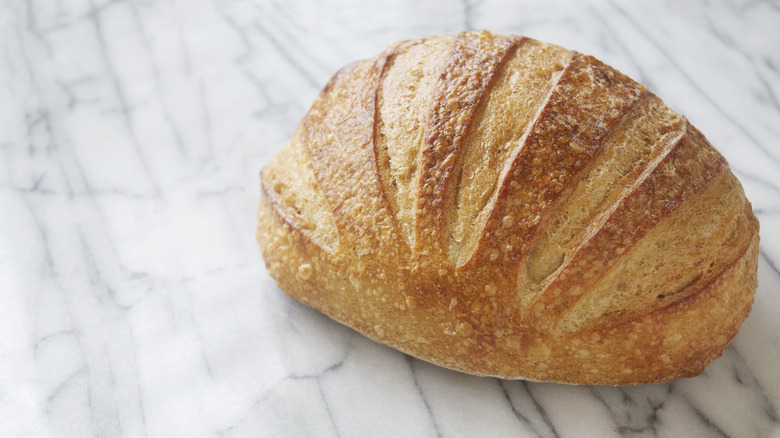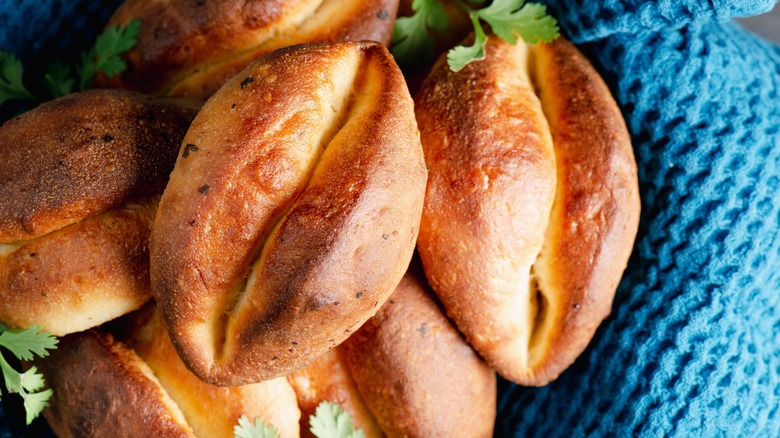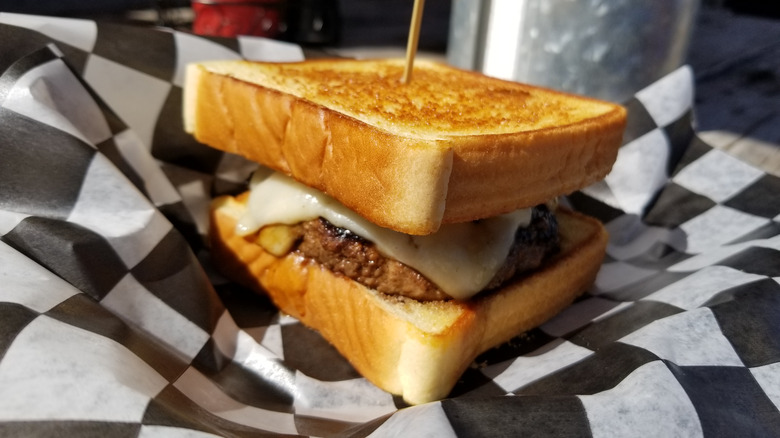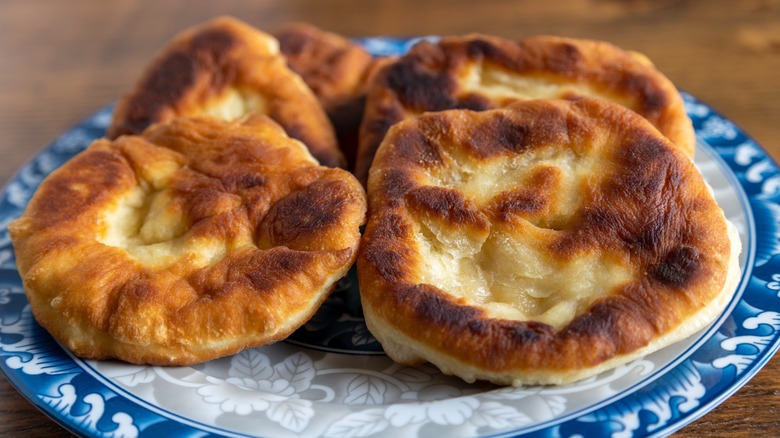18 Breads From Around The US You Need To Try At Least Once
We may receive a commission on purchases made from links.
For around 30,000 years, bread has been a cornerstone of our diet. Unlike meat or fish, it did not need to be hunted, while making flour and turning it into bread is a lesson in human development. Bread has many health benefits, not least being a source of fiber, vitamins, and minerals. It comes in a wide range of sizes, shapes, and flavors. From crusty, rustic loaves to sweet, soft rolls: They all taste delicious.
Some breads have their roots in the ancient past or make use of nature's bounty, and it has an important role in society, too. "Breaking bread" is more than just a phrase: It reinforces the ties that bind. With all this in mind, let's take a look at breads from around the U.S. you need to try at least once, and learn about both the history behind these kinds of bread, but also where to find them and how to make them today.
Salt rising bread
With its roots in 18th-century West Virginia, salt-rising bread spread to New York and Los Angeles, before being eclipsed by mass-produced loaves. It's not surprising. Salt rising bread needs coddling: Eight to 10 hours of fermentation at a steady temperature, and the cheesy-foot smell of the potato-based starter – generated by the clostridium perfringens bacteria – isn't pleasant.
Happily, the slow food trend has led to a revival of this homemade bread, with books like "Salt Rising Bread" retelling the bread's story. Instead of a pilot light or hearth, modern bakers use sous vide systems to achieve the 104 F to 110 F needed to kick-start the bacteria. But the end result is still around today for a reason, as it's actually more sweet than salty, and overall very unique.
Anadama bread
Many recipes are the results of happy accidents but considerably fewer are caused by temper tantrums. If the myth about an 1800s Massachusetts fisherman is to be believed, that's how Anadama bread came about. The story goes that, fed up with his wife's dull porridge, he put in yeast, molasses and cornmeal to pep up the recipe, while muttering either "Anna, damn you" or "Anna, damn her."
Anadama bread is easy to make, with many recipes calling for wheat flour, cornmeal, yeast, molasses, butter or shortening, and either water or milk. Some cooks warm the milk first. The result is a dense, delicious bread that is perfect for sandwiches or with a bowl of soup, and remains beloved by New Englanders to this day.
Amish friendship bread
From a distance, Amish friendship bread looks more like a cake and although it the recipe calls for vanilla, sugar, and cinnamon, don't be fooled — it's definitely a bread. It represents "the Amish community's values of simplicity, generosity, and interconnectedness," according to Tobin Dimmitt.
Nobody really knows where the concept behind Amish Friendship bread originated, but speculated it was based on a similar German recipe. Dimmitt cited "The Amish Cook" by Elizabeth Coblentz, who said it was a sourdough starter — a key ingredient which, like the bread itself, should be shared among the community.
Happily for anyone who is pressed for time, you can make Amish Friendship bread without the 10-day starter. Either way, you get a tangy, sweet rustic loaf that is perfect for sharing.
Dum bread
The name of this bread, popular in the U.S. Virgin Islands, has nothing to do with brains and everything to do with baking. Dum bread — also known as Johnny Cake — is cooked on a skillet, the 'dum' method islanders called using a Dutch oven, believed to have been favored by Indian workers who came to the Caribbean after the abolition of slavery.
Dumb bread does live up to its name regarding cooking, because it is super-easy to make. The dough is made from flour, sugar, butter or shortening and milk, though some recipes add cornflour and others coconut. Everything quickly combined and then gently kneaded into a soft, smooth dough. Depending on the recipe, it can be left to rest for 15 minutes, an hour or not at all, before cooking into a cake-bread hybrid.
Pueblo bread
Almost every community has their own form of bread, and so it goes for the Pueblo people of the American Southwest. Made from the simplest of ingredients — wheat flour, fat, water, and salt — and left overnight to rise, pueblo bread comes in a wide range of shapes and sizes.
The loaves are usually cooked in big batches for multiple families, using wood-burning adobe ovens which are typically built and operated by the community's women. They also prepare the dough for baking, using recipes and methods that have been passed down the family line over the years to create a crunchy, classic bread.
Gabubu bread
South Dakota is home to this simple but tasty bread, named after the Lakota word to 'knead' or 'pound'. It is made from a combination of flour, milk, fat, baking powder and salt, which Lakota Native Americans fried rather than baked.
In a video demonstrating how to make gabubu bread, Cera Swiftwater-Hayes used warm milk, wryly advising viewers to keep adding it to the dry mixture "until your ancestors tell you to stop." Swiftwater-Hayes also recommended not over-kneading the dough, and cutting a small slit in the flattened rounds before frying, so they cook evenly.
Lisa Ironcloud, who works with food sovereignty programs focused on Lakota-style cooking, told Argus Leader: "We grew up on that bread because we were poor and it filled our stomachs. Whenever we had meals with family and gabubu bread, those were happy moments... When you think of gabubu bread you think of home, which is South Dakota."
Dilly casserole bread
We have Nebraska's Leona Schnuelle to thank for this recipe, which won her the annual Pillsbury Bake-Off Grand Prize in 1960. The Pillsbury recipe includes 2 teaspoons of dill seed, a small cup of curd creamed cottage cheese, and instant minced onion, though you can also use the fresh kind.
The Bake-Off judges said the resulting bread was great for barbecues and patio luncheons. There's a final finishing touch that can be added to the dilly casserole bread after it's cooked, too.
In a video for Delight of the Bite, Katy Krippaehne copied something she watched her mom do when she was a child: Rubbing the top of the bread with a stick of butter straight from the fridge. As for the taste? Krippaehne said it brought to mind sour cream and onion chips.
Acorn bread
In her 2023 cookbook "Chími Nu'am", Sara Calvosa Olson brings to life some of California's oldest foods and techniques for home cooks. Among the recipes is acorn bread. In it, Calvosa Olson wrote: "Acorns are a cornerstone staple food for most Native communities. The nuts from the oak tree, all acorns are edible with the proper processing."
Making acorn flour, the key component of this bread, takes a lot of hard work, including leaching out tannins that taste soapy and can make some people sick. If you have the time and energy, then the nutty, earthy flavor acorn flour lends to bread is worth it.
Calvosa Olson blends bread flour into her recipe, as well as a dash of fennel pollen. "I love this savory floral aromatic," she wrote in "Chími Nu'am." "It grows everywhere, it's not endangered in any way... You have very little chance of stepping on anybody's toes in a fennel patch."
Piki bread
This extraordinary blue-gray bread comes from Arizona's Hopi tribe, and is laden with symbolism for the community that prizes it. Piki bread is made from finely ground blue corn — a sacred plant to the Hopi that they connect to both the southwest region of the U.S. and rainfall.
Women mix the corn with ashes of burned juniper berries and water to create a batter. A wafer-thin layer is spread onto a hot stone that has been cared for and polished by the women, before being almost instantly whipped off and rolled into a large tube.
The baking stones have great value to the Hopi, and both they and the techniques of making this bread are passed on from mother to daughter. Piki bread is often served at special occasions, and is sweet and smoky at the same time.
Graham bread
Connecticut-born Sylvester Graham is renowned for the cracker that bears his name, but Graham bread — made with the same coarse flour he developed — preceded it. The 19th-century Presbyterian minister was a vocal critic of Boston's commercial bakers and their poor-quality products, and his "A Treatise on Bread and Bread-Making" survives to this day.
So does his delicious, hearty bread, albeit now made with much better-quality Graham flour. Some recipes blend all-purpose or bread flour, while others include that store cupboard staple molasses or sugar, giving Graham bread a hint of sweetness.
In Sarah Josepha Hale's "The Good Housekeeper, or the Way to Live Well and to Be Well While We Live," she wrote about Graham bread: "It is an excellent article of diet for the dyspeptic and the costive; and for most persons of sedentary habits, would be beneficial. It agrees well with children; and, in short, I think it should be used in every family."
Bulkie roll
Not to be confused with Kaiser rolls, New Englanders have loved bulkie rolls — often pronounced 'boo-key' — for decades. This popular sandwich bread is bigger and crustier than a hamburger roll, and can be found in delis, restaurants and bakeries.
The name bulkie could come from the Yiddish for a small bread roll, or the Polish word 'bułka.' Bulkie rolls are a round, white bread and have little distinct flavor or texture. Although they are not as sweet as Kaiser rolls, they can sometimes have poppy seeds on top. Among the most iconic places to buy bulkies were Widoff's and Lederman's on Water Street in Worcester, both of which are now closed.
Scali bread
Scali bread has been a staple for Boston foodies for many years, even if its origins are lost in the mists of time. In a 2018 blog, John Regan claimed this plaited bread was so highly prized that it was delivered to his neighborhood in secret from a bakery in Boston's North End.
Scali bread's starter is closer to a dough than a liquid, while the ingredients list includes dry milk and a slug of olive oil. Scali bread's delicious, nutty flavor comes from the hefty sprinkling of sesame seeds on the top, though you can also use herbs or poppy seeds.
Beneath that golden, plaited crust lies a soft, fluffy interior and it is delicious dipped in a pasta sauce and great for sandwiches. Scali bread takes awhile to go stale, but even when it does, it still tastes good in soup.
Johnnycake
Not to be confused with the Caribbean bread or Canadian cornmeal cake of the same name, this johnnycake dates back to the 17th-century when hungry Pilgrim settlers in New England were taught to make them by Pawtuxet locals.
Another origin story has Rhode Island Native Americans mixing ground corn with a little water and cooking the patties in a campfire's ashes. Johnnycakes from this region were made solely from white corn flour ground by a watermill, and locals still hold annual competitions to bake and eat them.
Although known as flatbread, johnnycakes are essentially pancakes, because their ingredients are a combination of flour, water or milk, and a little salt. The batter is dripped onto a hot, greased pan, and the johnnycake is flipped when the underside is brown. They're a popular breakfast food, and can be either sweet or savory.
Cuban bread (pan Cubano)
Who would have thought that a combination of flour, water, lard, and salt would lead to the complex and much-loved pan Cubano, or Cuban bread? At a glance, it resembles a baguette but this cloud-soft loaf, with its pale, thin crust, is nothing like the hefty French staple.
Pan Cubano is a key component of Cuban sandwiches, and the lard used in the bread enhances their amazing pulled pork and ham filling — though it can get a bit messy. While Cuban bread is available to buy in bigger cities, the best only comes from south Florida, and you're hard-pressed to find as-good quality elsewhere.
San Francisco sourdough bread
We have cherished sourdough starters for thousands of years, and in California, we have the gold rush to thank for San Francisco sourdough bread. Legend has it that migrant Basque miners brought or made their own bread starters, but found their baked loaves tasted more sour than usual.
The distinctive, tangy taste and chewy texture was attributed to the bacteria in the starter, now known as lactobacillus sanfranciscensis, after it was identified in 1969. However, some also claimed it was influenced by San Francisco's notorious climate.
The bakery Boudin founded still uses a mother dough, initially begun in 1849, to this day, allegedly taking a spoonful of a miner's starter to create the iconic sourdough French bread. Rumor has it that, when the Great San Francisco Earthquake hit in 1906, quick thinking by Boudin's wife Louise prevented the starter from being destroyed. Way to go Louise!
Parker House Rolls
The hospitality industry can be challenging but, once in a while, when someone lets off steam, it results in fabulous food. That's the case for Parker House rolls, named after the Boston hotel and created in the 1870s. The story goes that an argument with a guest prompted the hotel's baker to angrily slam a batch of unfinished bread into the oven.
When they were taken out, the breads were crispy on the outside, with a light, fluffy interior. They also had what would become their iconic shape: The dough had folded in on itself while cooking to create their unique 'pocketbook' form.
Henry Wadsworth Longfellow, Charles Dickens and the Kennedy family were all big fans of Parker House rolls. They are popular among home cooks, too, as they pair well with almost anything, are easily freezable, and throwing them around to get that signature shape is not a requirement.
Texas toast
The slogan "everything is bigger in Texas" doesn't just apply to hats, hair, and the size of the state. It's the perfect description for Texas toast, too. At up to 1 inch thick, it is roughly twice that of a standard piece of bread, making it ideal for mopping up dishes with sauces or gravy (and it's so good that it doesn't deserve the treatment of going into your brown sugar storage).
Texas toast isn't as old as some of the breads available around the U.S., with a history going back to the 1940s, and two Pig Stand outlets in Denton and Beaumont. They both claim to have invented the snack, after their cooks used a griddle to brown bread that was too thickly sliced for an electric toaster.
Whoever is responsible, bread lovers have been grateful ever since. Texas toast makes for delicious, jumbo grilled cheese sandwiches, and if you're looking for a moreish way to serve French toast, then it's well worth trying the Lone Star state's bread.
Frybread
Many U.S. breads come with romantic, strange or funny tales about their origins, but few have as much emotion and complexity as frybread. Navajo Native Americans called it 'bááh dah díníilghaazh,' which describes the noise the hot oil makes as it cooks the dough.
Frybread was created in 1864, after hundreds of Navajo people were forcibly removed from their Arizona lands to New Mexico. During what became known as The Long Walk, their government provisions included flour, sugar, and lard, which the Native Americans used to make frybread. Although it lacked real nutritional value, it filled their bellies.
Today, frybread is regarded both as a symbol of pain and pride, and has been at the center of a row about obesity and diabetes among Native American communities. Despite the controversy, the crispy yet fluffy bread remains a sweet and savory favorite for many.
